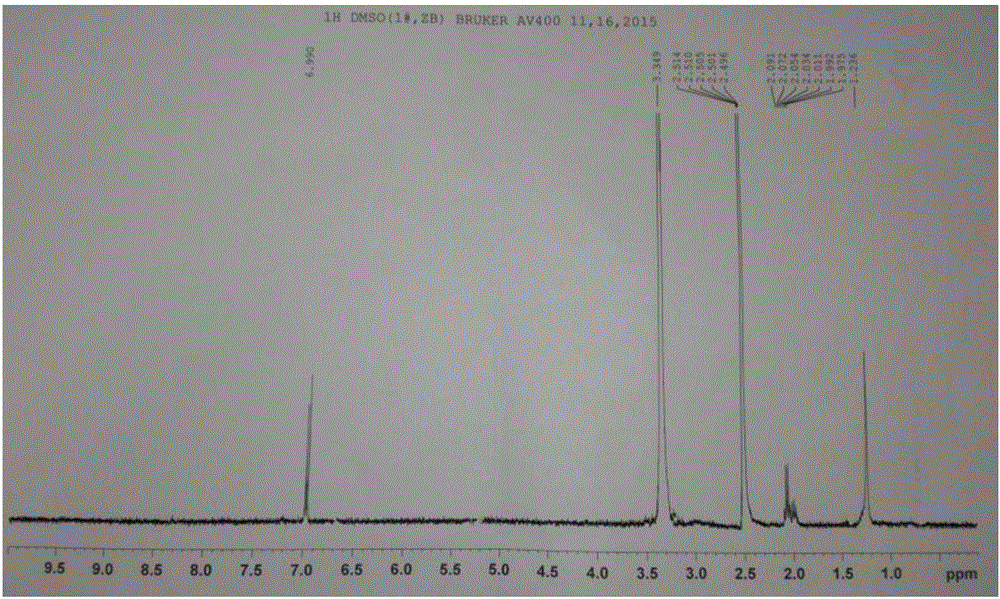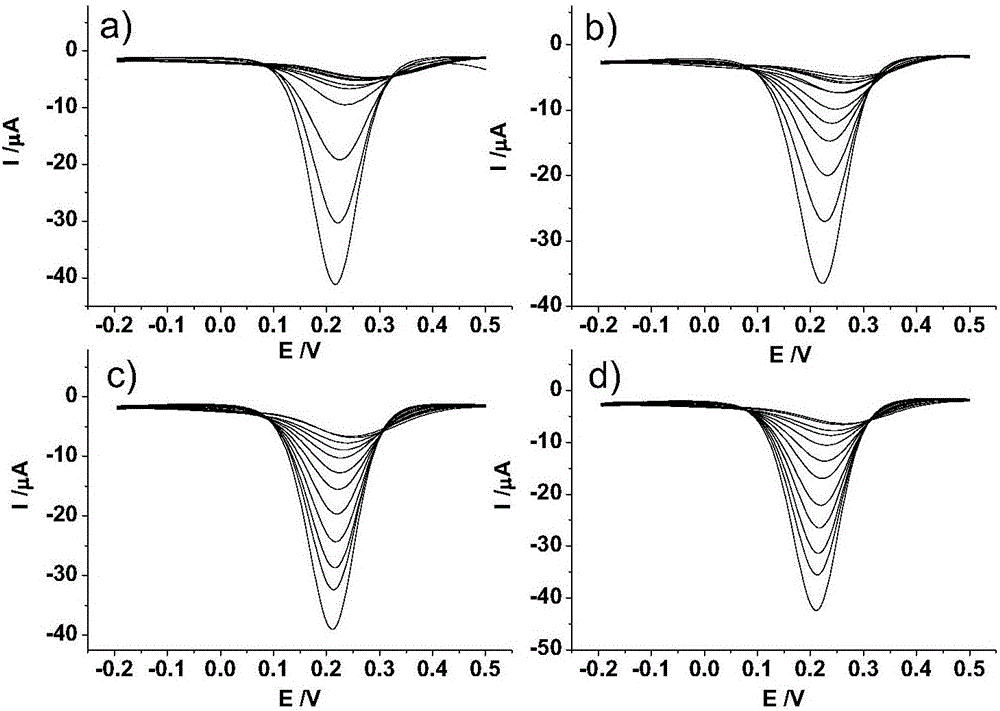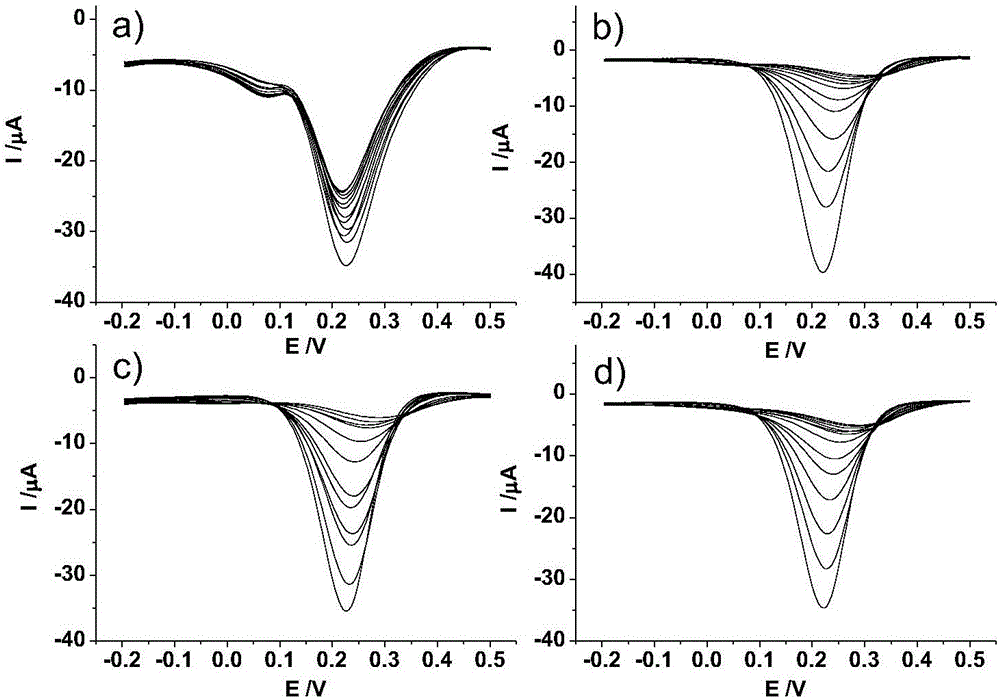Electrochemistry sensor for measuring organophosphorus pesticide residues and measurement method thereof
A technology of organophosphorus pesticides and detection methods, applied in the direction of material electrochemical variables, scientific instruments, instruments, etc., can solve the problems of unfavorable repeatability and reliability, difference in selectivity and activity, and inability to realize on-site detection, etc., to achieve enhanced stability Reproducibility and repeatability, short detection time, and the effect of saving detection time
- Summary
- Abstract
- Description
- Claims
- Application Information
AI Technical Summary
Problems solved by technology
Method used
Image
Examples
Embodiment 1
[0039] Example 1 Preparation of sensor for electrochemical detection of organophosphorus pesticide residues
[0040] (1) Preparation of mercaptoethylamidophosphamide (TMA)
[0041] Dissolve methamidophos (0.1g) in 10mL hydrochloric acid (0.1mol / L), and stir for 1h under ice-bath conditions to prepare the hydrochloric acid solution of methamidophos; N-bromosuccinimide (NHS, 0.542g ) and 1-(3-dimethylaminopropyl)-3-ethylcarbodiimide hydrochloride (EDC, 0.254g) were dissolved in phosphate buffer and stirred at room temperature for 3 hours, then slowly added mercapto Acetic acid (use sodium bicarbonate solution to adjust the pH to neutral) solution, continue to stir for 2 hours, add the resulting reactant to the hydrochloric acid solution of methamidophos and continue to stir at room temperature for 10 hours, then rotary evaporate most of the solvent at room temperature , a large amount of white solid was precipitated. Filter under reduced pressure and wash with a small amount o...
Embodiment 2
[0043] The independent detection of embodiment 2 organophosphorus standard sample
[0044] In this example, the organophosphorus standard samples are tested separately, and the organophosphorus pesticide samples are selected from fenthion, trichlorfon, dichlorvos, chlorpyrifos, parathion, diazinon, methamidophos, pirimiphos-methyl, dimethoate , phoxim and omethoate.
[0045] The electrochemical sensors prepared in Example 1 were respectively immersed in organic phosphorus concentrations of 0ng / mL, 1ng / mL, 10ng / mL, 50ng / mL, 100ng / mL, 200ng / mL, 400ng / mL, 600ng / mL, 800ng / mL, 1200ng / mL and 1500ng / mL PBS buffer solution (which all contain AchE at a concentration of 10μg / mL) for incubation, rinsed with PBS buffer solution and placed in a place containing K 3 [Fe(CN) 6 Carry out square wave voltammetry (SWV) scan in the PBS buffer solution of ], record response current; The response current of blank standard sample is I 0 , the response current of the standard sample containing o...
Embodiment 3
[0050] The standard addition detection of dichlorvos in embodiment 3 apples
[0051] Weigh the cleaned apple samples (three parallel samples, each with a mass of 50±0.005g) and put them into a beaker, add dichlorvos standard solution, then add 50mL water and 100mL acetone, grind and extract with a grinder for 3min. After filtration, take 100 mL of filtrate and place it in a separatory funnel, add 15 g of sodium chloride, shake vigorously for 3 minutes and then let it stand still. After the solution is separated, extract the aqueous phase with 50 mL of dichloromethane, and combine the acetone and dichloromethane extracts. Dry with anhydrous sodium sulfate to remove the water, concentrate by rotary evaporation to about 2mL, blow dry the remaining liquid with nitrogen, and finally add 10mL ethanol-water solution (V:V=1:1), shake until dissolved, store in low temperature and shade for later use .
[0052] A blank sample without adding dichlorvos was prepared according to the abov...
PUM
 Login to View More
Login to View More Abstract
Description
Claims
Application Information
 Login to View More
Login to View More - R&D
- Intellectual Property
- Life Sciences
- Materials
- Tech Scout
- Unparalleled Data Quality
- Higher Quality Content
- 60% Fewer Hallucinations
Browse by: Latest US Patents, China's latest patents, Technical Efficacy Thesaurus, Application Domain, Technology Topic, Popular Technical Reports.
© 2025 PatSnap. All rights reserved.Legal|Privacy policy|Modern Slavery Act Transparency Statement|Sitemap|About US| Contact US: help@patsnap.com



